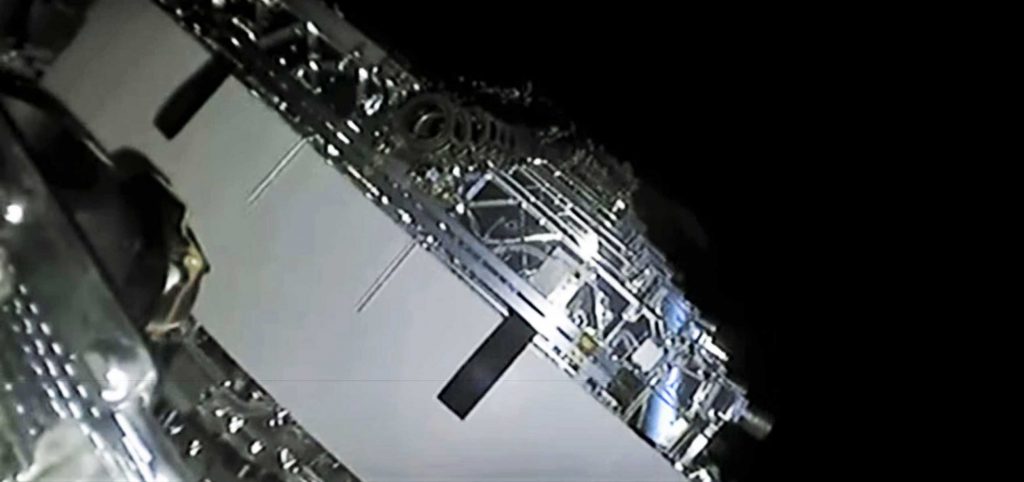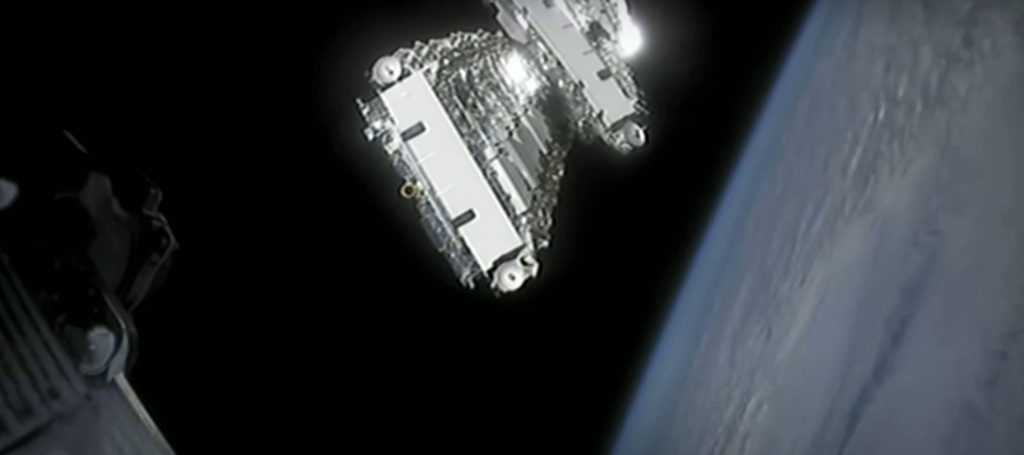

News
SpaceX building almost 1500 Starlink satellites per year
SpaceX has revealed a few key details about its burgeoning Starlink satellite internet constellation in a recent regulatory presentation, touching on overall investment, user terminal development, and its spacecraft manufacturing capabilities.
Already the single largest satellite constellation in the world by a factor of three or more, Starlink is more than 500 operational satellites strong after just nine months of launches, and the company has at least 5-8 more missions planned between now and the end of 2020. To further expand the world’s largest satellite constellation, though, SpaceX also needs to be the world’s most prolific satellite manufacturer by at least an order of magnitude.
Ever since SpaceX’s first dedicated Starlink launch in May 2019, the company has remained extremely secretive about the unprecedented satellite production infrastructure it also had to develop. Aside from a few comments by CEO Elon Musk and the occasional tidbit from regulatory documents or spaceflight conferences, very little is known and not a single photo has been released. An FCC ex parte presentation with a few specific details thus came as a surprise, revealing that SpaceX is building at least 120 Starlink satellites per month in its Redmond, Washington factory.

Based on past analysis of SpaceX’s Redmond facilities, the company has about 150,000 square feet (14,000 m^2) to work with, of which a third to half is likely dedicated to a satellite assembly line. Despite the relatively small facilities, SpaceX says it is actively building 120 satellites per month – equivalent to at least 1440 spacecraft annually. By mass, it means that SpaceX is churning out more than 30 metric tons (~69,000 lb) of satellites every single month, a figure almost certainly unprecedented in the history of satellite manufacturing.

Sustained over 12 months, that would equate to ~360 metric tons (10% heavier than a fully-fueled Falcon 9 V1.0 rocket) of satellites built every year. In short, with an extremely small (and thus efficient) base of operations, SpaceX is regularly producing a vast quantity of satellites – enough to indefinitely sustain two full Starlink launches per month. At that rate, SpaceX could fairly easily complete the Starlink constellation’s first ~4400-satellite phase in just three years.
Production capacity or efficiency would need to expand significantly for SpaceX to complete the second (~12,000 satellites) and third (~40,000 satellites) phases of the Starlink constellation, By then, though, the first phase would likely be generating substantial revenue, optimistically allowing SpaceX to self-fund future growth or at least dramatically reducing the need for fundraising.




Along those lines, the same FCC ex parte presentation included a note that “SpaceX has invested hundreds of millions of dollars in Starlink to date,” including “over $70 million developing and producing thousands of user terminals per month.” In other words, SpaceX has apparently spent less – and possibly much less – than $1 billion designing, manufacturing, and launching almost 600 satellites. For comparison, competitor OneWeb apparently spent more than $3.4 billion and filed for bankruptcy before it had launched even 100 satellites.
That exceptional efficiency will, as CEO Elon Musk has noted several times, hopefully make Starlink the first low Earth orbit (LEO) satellite internet constellation in history to not go bankrupt. The company hopes to begin rolling out a much wider Starlink beta test after the 14th v1.0 satellite launch – currently four launches away. If all goes well during that beta test, Starlink could become the first LEO internet constellation in history to begin generating significant revenue not long after.
Check out Teslarati’s Marketplace! We offer Tesla accessories, including for the Tesla Cybertruck and Tesla Model 3.
News
Tesla begins Robotaxi certification push in Arizona: report
Tesla seems serious about expanding its Robotaxi service to several states in the coming months.

Tesla has initiated discussions with Arizona transportation regulators to certify its driverless Robotaxi service in the state, as per a recent report from Bloomberg News. The move follows Tesla’s launch of its Robotaxi pilot program in Austin, Texas, as well as CEO Elon Musk’s recent comments about the service’s expansion in the Bay Area.
The Arizona Department of Transportation confirmed to Bloomberg that Tesla has reached out to begin the certification process for autonomous ride-sharing operations in the state. While details remain limited, the outreach suggests that Tesla is serious about expanding its driverless Robotaxi service to several territories in the coming months.
The Arizona development comes as Tesla prepares to expand its service area in Austin this weekend, as per CEO Elon Musk in a post on X. Musk also stated that Tesla is targeting the San Francisco Bay Area as its next major market, with a potential launch “in a month or two,” pending regulatory approvals.
Tesla first launched its autonomous ride-hailing program on June 22 in Austin with a small fleet of Model Y vehicles, accompanied by a Tesla employee in the passenger seat to monitor safety. While still classified as a test, Musk has said the program will expand to about 1,000 vehicles in the coming months. Tesla will later upgrade its Robotaxi fleet with the Cyercab, a two-seater that is designed without a steering wheel.
Sightings of Cybercab castings around the Giga Texas complex suggests that Tesla may be ramping the initial trial production of the self-driving two-seater. Tesla, for its part, has noted in the past that volume production of the Cybercab is expected to start sometime next year.
In California, Tesla has already applied for a transportation charter-party carrier permit from the state’s Public Utilities Commission. The company is reportedly taking a phased approach to operating in California, with the Robotaxi service starting with pre-arranged rides for employees in vehicles with safety drivers.
News
Tesla sets November 6 date for 2025 Annual Shareholder Meeting
The automaker announced the date on Thursday in a Form 8-K.

Tesla has scheduled its 2025 annual shareholder meeting for November 6, addressing investor concerns that the company was nearing a legal deadline to hold the event.
The automaker announced the date on Thursday in a Form 8-K submitted to the United States Securities and Exchange Commission (SEC). The company also listed a new proposal submission deadline of July 31 for items to be included in the proxy statement.
Tesla’s announcement followed calls from a group of 27 shareholders, including the leaders of large public pension funds, which urged Tesla’s board to formally set the meeting date, as noted in a report from The Wall Street Journal.
The group noted that under Texas law, where Tesla is now incorporated, companies must hold annual meetings within 13 months of the last one if requested by shareholders. Tesla’s previous annual shareholder meeting was held on June 13, 2024, which placed the July 13 deadline in focus.
Tesla originally stated in its 2024 annual report that it would file its proxy statement by the end of April. However, an amended filing on April 30 indicated that the Board of Directors had not yet finalized a meeting date, at least at the time.
The April filing also confirmed that Tesla’s board had formed a special committee to evaluate certain matters related to CEO Elon Musk’s compensation plan. Musk’s CEO performance award remains at the center of a lengthy legal dispute in Delaware, Tesla’s former state of incorporation.
Due to the aftermath of Musk’s legal dispute about his compensation plan in Delaware, he has not been paid for his work at Tesla for several years. Musk, for his part, has noted that he is more concerned about his voting stake in Tesla than his actual salary.
At last year’s annual meeting, TSLA shareholders voted to reapprove Elon Musk’s compensation plan and ratified Tesla’s decision to relocate its legal domicile from Delaware to Texas.
Elon Musk
Grok coming to Tesla vehicles next week “at the latest:” Elon Musk
Grok’s rollout to Tesla vehicles is expected to begin next week at the latest.

Elon Musk announced on Thursday that Grok, the large language model developed by his startup xAI, will soon be available in Tesla vehicles. Grok’s rollout to Tesla vehicles is expected to begin next week at the latest, further deepening the ties between the two Elon Musk-led companies.
Tesla–xAI synergy
Musk confirmed the news on X shortly after livestreaming the release of Grok 4, xAI’s latest large language model. “Grok is coming to Tesla vehicles very soon. Next week at the latest,” Musk wrote in a post on social media platform X.
During the livestream, Musk and several members of the xAI team highlighted several upgrades to Grok 4’s voice capabilities and performance metrics, positioning the LLM as competitive with top-tier models from OpenAI and Google.
The in-vehicle integration of Grok marks a new chapter in Tesla’s AI development. While Tesla has long relied on in-house systems for autonomous driving and energy optimization, Grok’s integration would introduce conversational AI directly into its vehicles’ user experience. This integration could potentially improve customer interaction inside Tesla vehicles.
xAI and Tesla’s collaborative footprint
Grok’s upcoming rollout to Tesla vehicles adds to a growing business relationship between Tesla and xAI. Earlier this year, Tesla disclosed that it generated $198.3 million in revenue from commercial, consulting, and support agreements with xAI, as noted in a report from Bloomberg News. A large portion of that amount, however, came from the sale of Megapack energy storage systems to the artificial intelligence startup.
In July 2023, Musk polled X users about whether Tesla should invest $5 billion in xAI. While no formal investment has been made so far, 68% of poll participants voted yes, and Musk has since stated that the idea would be discussed with Tesla’s board.
-

 Elon Musk1 week ago
Elon Musk1 week agoTesla investors will be shocked by Jim Cramer’s latest assessment
-

 Elon Musk3 days ago
Elon Musk3 days agoElon Musk confirms Grok 4 launch on July 9 with livestream event
-

 Elon Musk18 hours ago
Elon Musk18 hours agoxAI launches Grok 4 with new $300/month SuperGrok Heavy subscription
-

 News7 days ago
News7 days agoTesla Model 3 ranks as the safest new car in Europe for 2025, per Euro NCAP tests
-

 Elon Musk2 weeks ago
Elon Musk2 weeks agoA Tesla just delivered itself to a customer autonomously, Elon Musk confirms
-

 Elon Musk1 week ago
Elon Musk1 week agoxAI’s Memphis data center receives air permit despite community criticism
-

 Elon Musk2 weeks ago
Elon Musk2 weeks agoTesla’s Omead Afshar, known as Elon Musk’s right-hand man, leaves company: reports
-

 News2 weeks ago
News2 weeks agoXiaomi CEO congratulates Tesla on first FSD delivery: “We have to continue learning!”

















